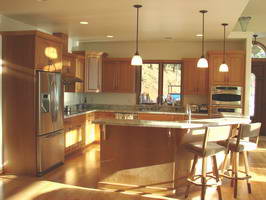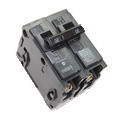Troubleshoot Home Electrical Power Problems
 '; ';
|
Electrical Power will Go Out and Come Back On: How to Locate Home Electrical Power Problems, Most Common Steps for Electrical Troubleshooting for Power Problems. © By: Dave Rongey |
Guide to Home Electrical Problems and How to Fix Them
Electrical Question:I have been having some weird electrical problems in 2 different areas of my house.
- The living room area is on a separate circuit breaker and the back bedroom & bathroom on another breaker.
- The power will go out and come back on within a few seconds but only in 2 different areas on 2 different breakers.The other parts of the house does not loose power.
- I called our electric company and they visually checked wire from pole to meter, they even pulled the meter and checked connections and voltage.
- I have felt all of the breakers by hand and none of them feel hot. I felt all of the receptacle outlets in living room & bedroom & bathroom, none of them feel hot.
- At no time has either of the circuit breakers been tripped but I shut them off and turned them back on and they seem to be tight and feel like they are good.
- The house was built in 1978 so could it be the circuit breakers at 34 yrs old are going bad?
This home electrical repairs question came from: Bob in Indiana.
Dave’s Reply:
Thanks for your electrical troubleshooting question Bob.
How to Locate Home Electrical Power Problems
Application: Troubleshooting – Testing Electrical Circuit Wiring.
Skill Level: Advanced – Best performed by an licensed electrical contractor who is has experience with electrical troubleshooting.
Tools Required: Basic Electricians Pouch Hand Tools, Voltage Tester, Continuity Tester, and Clamp on Amp Meter.
Estimated Time: Depends on experience and level of problem solving skills.
Precaution: Testing live wires is dangerous and should be done by an experienced individual only. Testing using a continuity tester should only be made after the circuit has been identified and turned OFF and Tagged.
DANGER: Working in electrical panels can produce electric shock and arc flash hazards, therefore is recommended for experienced electricians only.
Most Common Steps for Electrical Troubleshooting for Power Problems
- Electrical Power will Go Out and Come Back On
- When a home electrical system experiences intermittent power this usually indicates that there is a loose connection, a deteriorating connection, or a faulty component within the electrical circuit.
- The goal is to isolate the problem to the specific circuit that is having the problem.
- Typically there will be a problem with the neutral wire, or the power conductor of the affected circuit.
- Problems with More than One Circuit
- If the problem occurs with two separate locations that are served from two separate circuit breakers then most likely there is a faulty connection or splice with the neutral wire of a multiwire circuit.
- Multiwire circuit connections should be checked starting at the panel, with careful attention focused on the termination of the neutral wire to the terminal strip.
- Often the unbalanced loads of a multiwire circuit will create an overloaded neutral wire which can cause a deteriorating condition which can lead to arcing and an intermittent connection.
- When All of the Home Has a Electrical Power Problem
- If all of the home electrical circuits are experiencing the same problem then you should call the local electrical service provider and explain the problem.
- If the electric power company has determined that the service to the home is OK, then the problem is within the home electrical system which will require further evaluations.
- Problems With the Main Electrical Panel
- The home electrical system starts at the watt hour meter and consists of all of the electrical circuit wiring and components throughout the home and other associated panels.
- Most home electrical services consist of two main circuits of power that is distributed throughout the home electrical system through a number of carefully designed circuits.
- The home electrical system shares one main neutral conductor wire. If the amperage or power load of the two main power conductors of the main service are not balanced properly this can cause an overloaded condition of the primary neutral which can lead to connection faults of the neutral.
- NOTE: An unbalanced load of the home electrical system can also cause higher electric bills because the power is not being used efficiently.
- Circuit Loads and Expansion and Contraction Problems
- Due to the electric load that is placed onto a circuit, the circuit components will experience a change in temperature. The higher the circuit amperage load, the higher the temperature, therefore the circuit design is vitally important to prevent an overload and overheated condition.
- Changes in weather can cause stress of the circuit components, such as hot summer heat and the use of equipment such as air conditioners.
- Circuit components expand and contract in proportion to the amount of heat produced by the amperage of the circuit, therefore the expansion and contraction within circuit components may produce a loose connection of a wire conductor, terminal lug, wire splice, or even a circuit breaker, all of which can result in a deteriorating connection which can lead to a failure within the circuit.
- Checking Individual Electrical Circuits
- The circuits of the electrical panel should be tested individually for faulty connections of the power wires to the circuit breakers and the neutral wire to the neutral terminal strip.
- Checking the Components of an Electrical Circuit
- Identify the specific circuit that is at fault and begin unplugging or disconnecting any device that is connected to this circuit. Special attention should be given to outlet receptacles where high powered devices are plugged in, such as space heaters and portable air conditioners which often produce faulty connections within the wiring of the outlet as well as a damaged wall outlet which should be replaced.
- Often the problem may be with a specific device that is connected to the circuit which has a fault and will need to be repaired, however it may be found that the connections of the power cord of the device to the receptacle outlet has become discolored and burnt which will require replacing the power cord and receptacle
More about Electrical Troubleshooting
-
Troubleshooting and Repairing Electrical Wiring
- Professional Electrician Reveals the Secrets of Successful Electrical Troubleshooting Methods used to solve the majority of the home electrical problems and wiring failures encountered.
Home Electrical Panel Circuit Listing
Home Electrical Circuit Breakers
-
Home Electrical Circuit Breakers
- A guide to home electrical circuit breakers and how they work to protect your electrical wiring. When properly installed, your home electrical wiring is protected by a circuit protection device.
Using Electrical Testers and Voltage Meters
-
Understanding Digital Volt Meters
- When working on home electrical wiring using voltage meter can play an important part in electrical safety. Electrical testers and voltage meters enable you to identify electrical circuits and help prevent the possibility of accidental electrical shock.
Types of Electrical Testers
Using Electrical Testers and Voltage Meters
The following may also be helpful for you:
|
|
Be Careful and Be Safe - Never Work on Energized Circuits!
Consult your Local Building Department about Permits and Inspections for all Electric Wiring Projects.
More articles about Electrical Troubleshooting and Home Electrical Wiring: |
|
| « Previous | Next » |
How to Repair a Hair Blow Dryer Outlet that Stopped Working |
Bathroom Light Fixture Wiring |















